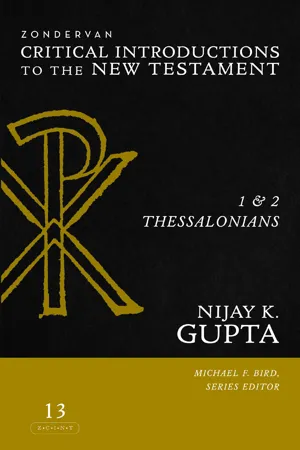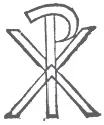MAJUSCULES
א (01): Pauline corpus
A (02): Pauline corpus
B (03): Pauline corpus
C (04): lacking 1:1, 2:9–5:28 (end)
D (06): Pauline corpus
F (010): Pauline corpus
G (012): Pauline corpus
H (015): contains only 2:9–13; 4:5–11
I (016): contains only 1:1–2, 9–10; 2:7–9, 14–16; 3:2–5, 11–13;
4:7–10; 4:16–5:1, 9–12, 23–27
K (018): Pauline corpus
L (020): Pauline corpus
P (025): lacking 3:5–4:17
Ψ (044): Pauline corpus
048: contains only 1:1, 5–6
0183: contains only 3:6–9; 4:1–5
0208: 2:4–7, 12–17
0226: 4:16–5:5
0278: all of 1 Thess
Major Textual Variants in 1 Thessalonians
There are fourteen verses in 1 Thessalonians with textual variant discussions worth consideration.2
1:1 χάρις ὑμῖν καὶ εἰρήνη
The NA28/UBS5 text of 1 Thessalonians 1:1 ends with χάρις ὑμῖν καὶ εἰρήνη. Some manuscripts contain a longer salutation such as ἀπὸ θεοῦ πατρὸς καὶ κυρίου Ἰησοῦ Χριστοῦ (e.g., D 0150 256 263 1319 1573 2127 l 593).3 Similarly, we also find ἀπὸ θεοῦ πατρὸς ἡμῶν καὶ κυρίου Ἰησοῦ Χριστοῦ (e.g., א A I 6 33 81 104). The best and earliest manuscripts support the short reading. Furthermore, the longer readings can be explained as assimilation to Pauline style (see 1 Cor 1:3).
1:5 εὐαγγέλιον ἡμῶν
While the reading “our gospel” is widely attested, apparently some copyists found the language of “our” inappropriate, thus omitting it. The witnesses אc and C read εὐαγγέλιον τοῦ θεοῦ (no ἡμῶν); similarly א* has εὐαγγέλιον τοῦ θεοῦ ἡμῶν.
2:7 νήπιοι
This is one of the most controversial text-critical issues in the whole Pauline corpus. We will devote more attention to historical and theological issues related to this text on pages 106–14. Here we will reserve ourselves primarily to comment only on the manuscript witnesses and potential unintentional scribal behavior. The two main options for textual readings are νήπιοι, which means “infants,” and ἤπιοι, “gentle.”
νήπιοι:
65 א* B C* D* F G I Ψ* 0150 104* 263 459 1962
l 147
l 592
l 593
l 603
c it
ar, b, d, f, g, mon, o vg
cl, ww cop
sams, bo eth Origen
(gr1/3), lat; Ambrosiaster Jerome Pelagius Augustine
ἤπιοι: אc A C2 D2 Ψc 075 6 33 81 104c 256 365 424 436 1241 1319 1573 1739 1852 1881 1912 2127 2200 2464 Byz [K L P] Lect vgst (syrp, h) copsamss, fay arm (geo) slav Clement Origen2/3 Basil Chrysostom Theodorelat
Metzger notes that νήπιοι could have occured by dittography (accidental repeating of a letter), or ἤπιοι by haplography (accidental omission of a letter).4 Nevertheless, Metzger’s committee preferred νήπιοι on account of “what is admittedly the stronger external attestation.”5
2:12 καλοῦντος
The weight of extant manuscript evidence favors καλοῦντος (present tense), but there are some manuscripts that have the aorist καλέσαντος (e.g., א A 104 459 1912 2464). The aorist variant could be explained as assimilation to Paul’s use of the aorist form in 1 Corinthians 1:9, Galatians 1:6, and 1 Thessalonians 4:7.6
2:15 προφήτας
Again, external evidence overwhelmingly supports the short reading, but some witnesses (including most minuscules, as well as the Textus Receptus) have the reading ἰδίους προφήτας, understood as “their own prophets” (i.e., Jewish prophets versus Christian prophets). Metzger wonders whether those witnesses that include the longer reading may have been influenced by Marcion’s text.7
2:16 ὀργή
Some later Western-type manuscripts add τοῦ θεοῦ to ὀργή to clarify the reference to God’s wrath. In the context, though, this addition is unnecessary and thus superfluous.
3:2 καὶ συνεργὸν τοῦ θεοῦ ἐν τῷ εὐαγγελίῳ τοῦ Χριστοῦ
Some manuscripts have διάκονον instead of συνεργόν. Another matter is τοῦ θεοῦ—it is occasionally omitted. Metzger argues that on external evidence alone, the reading καὶ διάκονον τοῦ θεοῦ is very strong, but the UBS choice {B} seems best able to explain how the other readings came into existence. He reasons that some copyists may have been uncomfortable with the idea of being “coworkers of God,” thus removing τοῦ θεοῦ to avoid confusion (is God a “coworker”?). Others preferred διάκονον to soften the language. Some manuscripts have both διάκονον and συνεργόν (F G itf, g).8
3:13 αὐτοῦ, [ἀμήν].
One cannot decide on the originality of ἀμήν based on external evidence alone, since both readings are strongly attested. Not much hangs on its inclusion, though one wonders why a copyist would exclude it.
4:1 καθὼς καὶ περιπατεῖτε
Though the inclusion of this clause is strongly attested, it is lacking in many minuscules. The most likely reason why it was dropped is because it could appear redundant.
4:11 [ἰδίαις]
There is fairly even manuscript support for the inclusion of ἰδίαις: ἐργάζεσθαι ταῖς [ἰδίαις] χερσὶν ὑμῶν. The UBS committee was undecided {C}. It may have been dropped because it could appear unnecessary.
Includes: א* A D1 33 81 424* 436 1241 1852 1962 2200 Byz [K L] Omits: א2 B D* F G Ψ 075 0150 6 104 256 263 365 424c
4:13 κοιμωμένων
The Western and Byzantine witnesses tend to read here κεκοιμημένων, while the Alexandrian witnesses favor κοιμωμένων. The latter is preferred, supported by more ancient texts; moreover, κοιμωμένων (present tense) is the more difficult reading.
5:25 [καί]
Does the text read “pray for us” or “pray also for us”? Encouragement for apostolic prayer is found in Colossians 4:3: προσευχόμενοι ἅμα καὶ περὶ ἡμῶν. External evidence does not support one reading as stronger. Most translations do not add “also.”
5:27 ἀδελφοῖς
A number of minuscules (and evidence from non-Greek ancient translations) include ἅγιος (τοῖς ἁγίοις ἀδελφοῖς). The external evidence supports the shorter reading, and perhaps the addition of ἅγιος can be explained by its use in 5:26.
5:28 ὑμῶν
In the Alexandrian-type texts, 1 Thessalonians ends with ὑμῶν (“The grace of our Lord Jesus Christ be with you”). A large number of manuscripts (including א A Dc K L P Ψ 614 1739c), though, include a final ἀμήν, though this might be explained based on liturgical use.





